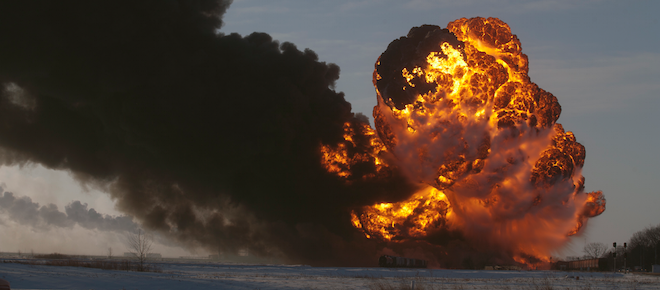EXPLAINER: Why did a train explode in North Dakota?
Freight trains carrying grain and crude collided on parallel tracks
A fireball goes up at the site of an oil train derailment Monday, Dec 30, 2013, in Casselton, N.D. The train carrying crude oil derailed near Casselton Monday afternoon. Several explosions were reported as some cars on the mile-long train caught fire. (AP Photo/Bruce Crummy)
Share

A large freight train explosion in North Dakota on Monday is raising concerns yet again about the safety of transporting vast amount of crude oil by rail. Even before the National Transportation Safety Board arrived on the scene to investigate the incident, the mayor of Casselton, a town of approximately 2,400 people that narrowly escaped the devastating effects of the explosion, said it’s time to “have a conversation” with federal lawmakers about the dangers of transporting crude oil on freight trains.
What happened?
A train operated by BNSF Railway was travelling west carrying grain about two kilometres west of Casselton, near Fargo, around 2:10 p.m. A portion of it derailed and fell on to another freight train, also operated by BNSF, that was travelling east on parallel tracks. The second train was carrying petroleum crude oil and a buffer car filled with sand to separate the tankers from the locomotives. The collision caused multiple loud explosions and huge, black plumes of smoke filled the air. BNSF operates more than 52,000 kilometres of tracks in 28 American states, as well as British Columbia and Manitoba.
Was anybody hurt?
Casselton narrowly avoided a disaster similar in scale to that which struck Lac-Mégantic, Que., when brakes on a driverless train carrying crude from North Dakota came undone near the small Quebec town. The 72-car train barrelled through Lac-Mégantic’s downtown core, killing 47 people. No injuries have been reported in North Dakota, but pollution from the blaze raised concerns about the air quality. As a precaution, the city advised its residents to evacuate voluntarily. About 65 per cent of Casselton’s 2,400 residents left their homes. Many stayed with friends and relatives. Robyn Litke-Sall, a spokesperson for the Cass County sheriff’s office, said 19 people and two pets stayed at a shelter set up by Red Cross Monday night at the Discovery Middle School in Fargo, about two kilometres east of Casselton. The evacuation order was lifted Tuesday afternoon at 3 p.m. local time.
Are derailments common in the area?
Casselton’s mayor, Ed McConnell, said numerous derailments have occurred in and around the town in the past few years.
“It’s almost gotten to the point that it looks like not if we’re going to have an accident, it’s when,” he told the Associated Press. “We dodged a bullet by having it out of town, but this is too close for comfort.”
Local news reports say the last time an oil train derailed in North Dakota was on Dec. 2, when a pick-up truck collided with the 104-car train. The train was empty, on its way from Oklahoma to be filled with North Dakota crude.
North Dakota is a major producer of both grain and oil. It is the second-largest producer of oil behind Texas. About 60 per cent of the state’s oil is transported by freight trains, and this number is expected to go up to 90 per cent in 2014.
BNSF transports oil from North Dakota and Montana daily. Amy McBeth, a spokeswoman for BNSF, told Maclean’s that the company’s employees specially trained to deal with hazardous materials are on site to work with local emergency responders to assist with resident’s concerns.
“We are thankful there have been no injuries as a result of the derailment near Casselton, North Dakota and are terribly sorry for the inconvenience this derailment has caused residents in the area,” McBeth said.
Who’s investigating the incident?
The National Transportation Safety Board, an independent federal agency appointed to investigate transportation accidents, arrived on the scene Tuesday morning to look at what factors contributed to the explosion.
“We’ll be looking at the following areas: the track condition, the mechanical condition of the trains, train recorders, the track signal system, operations including interviewing the train crews, hazardous materials and emergency response,” said NTSB spokesman Robert Sumwalt.
The agency will be in Casselton for five to seven days, but a final report is not expected for another 12-18 months. The NTSB is currently investigating another two train derailments in Louisiana and New York City. The former happened in August, when a derailed train leaked flammable and corrosive materials; the latter was a commuter train derailment that hit in early December. The NTSB is also working with Canada’s Transportation Safety Board to investigate the Lac-Mégantic disaster.
“We are very, very busy, especially in our rail division,” Sumwalt said.